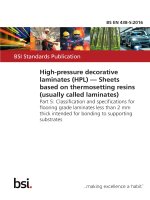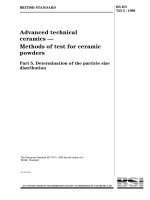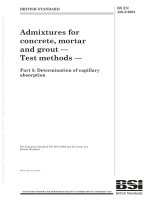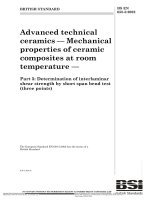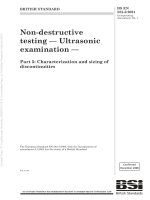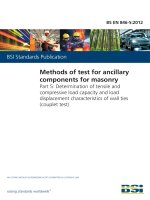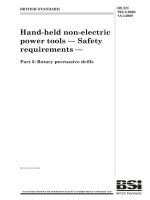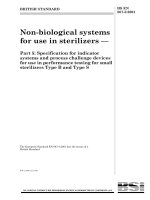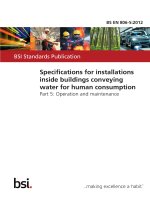Bsi bs en 61784 5 19 2013
Bạn đang xem bản rút gọn của tài liệu. Xem và tải ngay bản đầy đủ của tài liệu tại đây (1.46 MB, 46 trang )
BS EN 61784-5-19:2013
BSI Standards Publication
Industrial communication
networks — Profiles
Part 5-19: Installation of fieldbuses —
Installation profiles for CPF 19
BRITISH STANDARD
BS EN 61784-5-19:2013
National foreword
This British Standard is the UK implementation of EN 61784-5-19:2013. It is
identical to IEC 61784-5-19:2013.
The UK participation in its preparation was entrusted to Technical Committee AMT/7, Industrial communications: process measurement and
control, including fieldbus.
A list of organizations represented on this committee can be obtained on
request to its secretary.
This publication does not purport to include all the necessary provisions of
a contract. Users are responsible for its correct application.
© The British Standards Institution 2014.
Published by BSI Standards Limited 2014
ISBN 978 0 580 81616 1
ICS 25.040.40; 35.100.40
Compliance with a British Standard cannot confer immunity from
legal obligations.
This British Standard was published under the authority of the
Standards Policy and Strategy Committee on 31 January 2014.
Amendments/corrigenda issued since publication
Date
Text affected
BS EN 61784-5-19:2013
EN 61784-5-19
EUROPEAN STANDARD
NORME EUROPÉENNE
EUROPÄISCHE NORM
December 2013
ICS 25.040.40; 35.100.40
English version
Industrial communication networks Profiles Part 5-19: Installation of fieldbuses Installation profiles for CPF 19
(IEC 61784-5-19:2013)
Réseaux de communication industriels Profils Partie 5-19: Installation des bus de terrain
- Profils d'installation pour CPF 19
(CEI 61784-5-19:2013)
Industrielle Kommunikationsnetze Profile Teil 5-19: Feldbusinstallation Installationsprofile für die
Kommunikationsprofilfamilie 19
(IEC 61784-5-19:2013)
This European Standard was approved by CENELEC on 2013-10-14. CENELEC members are bound to comply
with the CEN/CENELEC Internal Regulations which stipulate the conditions for giving this European Standard
the status of a national standard without any alteration.
Up-to-date lists and bibliographical references concerning such national standards may be obtained on
application to the CEN-CENELEC Management Centre or to any CENELEC member.
This European Standard exists in three official versions (English, French, German). A version in any other
language made by translation under the responsibility of a CENELEC member into its own language and notified
to the CEN-CENELEC Management Centre has the same status as the official versions.
CENELEC members are the national electrotechnical committees of Austria, Belgium, Bulgaria, Croatia, Cyprus,
the Czech Republic, Denmark, Estonia, Finland, Former Yugoslav Republic of Macedonia, France, Germany,
Greece, Hungary, Iceland, Ireland, Italy, Latvia, Lithuania, Luxembourg, Malta, the Netherlands, Norway, Poland,
Portugal, Romania, Slovakia, Slovenia, Spain, Sweden, Switzerland, Turkey and the United Kingdom.
CENELEC
European Committee for Electrotechnical Standardization
Comité Européen de Normalisation Electrotechnique
Europäisches Komitee für Elektrotechnische Normung
CEN-CENELEC Management Centre: Avenue Marnix 17, B - 1000 Brussels
© 2013 CENELEC -
All rights of exploitation in any form and by any means reserved worldwide for CENELEC members.
Ref. No. EN 61784-5-19:2013 E
BS EN 61784-5-19:2013
EN 61784-5-19:2013
-2-
Foreword
The text of document 65C/738/FDIS, future edition 1 of IEC 61784-5-19, prepared by
SC 65C "Industrial networks" of IEC/TC 65 "Industrial-process measurement, control and automation"
was submitted to the IEC-CENELEC parallel vote and approved by CENELEC as
EN 61784-5-19:2013.
The following dates are fixed:
•
latest date by which the document has to be
implemented at national level by
publication of an identical national
standard or by endorsement
(dop)
2014-07-14
•
latest date by which the national
standards conflicting with the
document have to be withdrawn
(dow)
2016-10-14
This standard is to be used in conjunction with EN 61918:2013.
Attention is drawn to the possibility that some of the elements of this document may be the subject of
patent rights. CENELEC [and/or CEN] shall not be held responsible for identifying any or all such
patent rights.
Endorsement notice
The text of the International Standard IEC 61784-5-19:2013 was approved by CENELEC as a
European Standard without any modification.
BS EN 61784-5-19:2013
EN 61784-5-19:2013
-3-
Annex ZA
(normative)
Normative references to international publications
with their corresponding European publications
The following documents, in whole or in part, are normatively referenced in this document and are
indispensable for its application. For dated references, only the edition cited applies. For undated
references, the latest edition of the referenced document (including any amendments) applies.
NOTE When an international publication has been modified by common modifications, indicated by (mod), the relevant EN/HD
applies.
Annex ZA of EN 61918:2013 applies, except as follows:
Publication
Year
Title
EN/HD
Year
EN 61918
2013
Addition to Annex ZA of EN 61918:2013:
IEC 61918
2013
Industrial communication networks Installation of communication networks in
industrial premises
–2–
BS EN 61784-5-19:2013
61784-5-19 © IEC:2013
CONTENTS
INTRODUCTION ..................................................................................................................... 7
1
Scope ............................................................................................................................... 8
2
Normative references ....................................................................................................... 8
3
Terms, definitions and abbreviated terms ......................................................................... 8
4
CPF19: Overview of installation profiles ........................................................................... 8
5
Installation profile conventions ......................................................................................... 8
6
Conformance to installation profiles .................................................................................. 9
Annex A (normative) CP 19/1 (MECHATROLINK-II) specific installation profile ................... 11
A.1 Installation profile scope ................................................................................................. 11
A.2 Normative references ..................................................................................................... 11
A.3 Installation profile terms, definitions, and abbreviated terms ........................................... 11
A.3.1 Terms and definitions ............................................................................................ 11
A.3.2 Abbreviated terms ................................................................................................. 11
A.3.3 Conventions for installation profiles ....................................................................... 11
A.4 Installation planning ....................................................................................................... 12
A.4.1 General ................................................................................................................. 12
A.4.2 Planning requirements ........................................................................................... 12
A.4.3 Network capabilities .............................................................................................. 12
A.4.4 Selection and use of cabling components .............................................................. 14
A.4.5 Cabling planning documentation ............................................................................ 21
A.4.6 Verification of cabling planning specification ......................................................... 21
A.5 Installation implementation ............................................................................................. 22
A.5.1 General requirements ............................................................................................ 22
A.5.2 Cable installation ................................................................................................... 22
A.5.3 Connector installation ............................................................................................ 23
A.5.4 Terminator installation ........................................................................................... 24
A.5.5 Device installation ................................................................................................. 24
A.5.6 Coding and labelling .............................................................................................. 24
A.5.7 Earthing and bonding of equipment and devices and shield cabling ....................... 24
A.5.8 As-implemented cabling documentation ................................................................. 25
A.6 Installation verification and installation acceptance test .................................................. 25
A.6.1 General ................................................................................................................. 25
A.6.2 Installation verification ........................................................................................... 25
A.6.3 Installation acceptance test ................................................................................... 26
A.7 Installation administration ............................................................................................... 26
A.8 Installation maintenance and installation troubleshooting ............................................... 27
Annex B (normative) CP 19/2 (MECHATROLINK-III) specific installation profile ................... 29
B.1 Installation profile scope ................................................................................................. 29
B.2 Normative references ..................................................................................................... 29
B.3 Installation profile terms, definitions, and abbreviated terms ........................................... 29
B.3.1 Terms and definitions ............................................................................................ 29
B.3.2 Abbreviated terms ................................................................................................. 29
B.3.3 Conventions for installation profiles ....................................................................... 29
BS EN 61784-5-19:2013
61784-5-19 © IEC:2013
–3–
B.4 Installation planning ....................................................................................................... 29
B.4.1 General ................................................................................................................. 29
B.4.2 Planning requirements ........................................................................................... 29
B.4.3 Network capabilities .............................................................................................. 30
B.4.4 Selection and use of cabling components .............................................................. 31
B.4.5 Cabling planning documentation ............................................................................ 36
B.4.6 Verification of cabling planning specification ......................................................... 36
B.5 Installation implementation ............................................................................................. 37
B.5.1 General requirements ............................................................................................ 37
B.5.2 Cable installation ................................................................................................... 37
B.5.3 Connector installation ............................................................................................ 38
B.5.4 Terminator installation ........................................................................................... 38
B.5.5 Device installation ................................................................................................. 38
B.5.6 Coding and labelling .............................................................................................. 39
B.5.7 Earthing and bonding of equipment and devices and shield cabling ....................... 39
B.5.8 As-implemented cabling documentation ................................................................. 39
B.6 Installation verification and installation acceptance test .................................................. 39
B.6.1 General ................................................................................................................. 39
B.6.2 Installation verification ........................................................................................... 39
B.6.3 Installation acceptance test ................................................................................... 40
B.7 Installation administration ............................................................................................... 40
B.8 Installation maintenance and installation troubleshooting ............................................... 40
Bibliography .......................................................................................................................... 41
Figure 1 – Standards relationships .......................................................................................... 7
Figure A.1 – Topology of CP 19/1 network ............................................................................ 13
Figure A.2 – Network expansion using repeater .................................................................... 13
Figure A.3 – Structure of cable ............................................................................................. 15
Figure A.4 – Dimensions of single port device connector ...................................................... 17
Figure A.5 – Dimensions of dual ports device connector ....................................................... 17
Figure A.6 – Dimensions of cable connector ......................................................................... 18
Figure A.7 – Cable connector with inductors ......................................................................... 18
Figure A.8 – Terminator connection in cable connector housing ............................................ 19
Figure A.9 – Wiring example ................................................................................................. 23
Figure A.10 – Terminator installed in M-II cable connector .................................................... 24
Figure A.11 – Division of network segment by changing terminator location .......................... 28
Figure B.1 – Dimensions of IMI device connector .................................................................. 33
Figure B.2 – Dimensions of IMI cable connector ................................................................... 34
Table A.1 – Basic network characteristics for balanced cabling not based on Ethernet ......... 13
Table A.2 – Number of devices and maximum segment length .............................................. 14
Table A.3 – Information relevant to copper cable: fixed cables .............................................. 15
Table A.4 – Additional cable specifications ........................................................................... 15
Table A.5 – Connectors for copper cabling CPs not based on Ethernet ................................. 16
Table A.6 – Parameters for balanced cables ......................................................................... 22
Table A.7 – Pin assignment and wire colour coding for CP 19/1 connector ........................... 24
–4–
BS EN 61784-5-19:2013
61784-5-19 © IEC:2013
Table A.8 – Typical problems in a network with balanced cabling ......................................... 27
Table B.1 – Network characteristics for balanced cabling based on Ethernet ........................ 31
Table B.2 – Information relevant to copper cable: fixed cables .............................................. 31
Table B.3 – Information relevant to copper cable: cords ........................................................ 32
Table B.4 – Connectors for balanced cabling CPs based on Ethernet ................................... 33
Table B.5 – Parameters for balanced cables ......................................................................... 37
Table B.6 – Pin assignment and wire colour coding for CP 19/2 connector ........................... 38
BS EN 61784-5-19:2013
61784-5-19 © IEC:2013
–7–
INTRODUCTION
This International Standard is one of a series produced to facilitate the use of communication
networks in industrial control systems.
IEC 61918:2013 provides the common requirements for the installation of communication
networks in industrial control systems. This installation profile standard provides the
installation profiles of the communication profiles (CP) of a specific communication profile
family (CPF) by stating which requirements of IEC 61918 fully apply and, where necessary, by
supplementing, modifying, or replacing the other requirements (see Figure 1).
For general background on fieldbuses, their profiles, and relationship between the installation
profiles specified in this standard, see IEC 61158-1.
Each CP installation profile is specified in a separate annex of this standard. Each annex is
structured exactly as the reference standard IEC 61918 for the benefit of the persons
representing the roles in the fieldbus installation process as defined in IEC 61918 (planner,
installer, verification personnel, validation personnel, maintenance personnel, administration
personnel). By reading the installation profile in conjunction with IEC 61918, these persons
immediately know which requirements are common for the installation of all CPs and which
are modified or replaced. The conventions used to draft this standard are defined in Clause 5.
The provision of the installation profiles in one standard for each CPF (for example
IEC 61784-5-19 for CPF 19), allows readers to work with standards of a convenient size.
Figure 1 – Standards relationships
–8–
BS EN 61784-5-19:2013
61784-5-19 © IEC:2013
INDUSTRIAL COMMUNICATION NETWORKS –
PROFILES –
Part 5-19: Installation of fieldbuses –
Installation profiles for CPF 19
1
Scope
This part of IEC 61784 specifies the installation profiles for CPF 19 (MECHATROLINK™ 1).
The installation profiles are specified in the annexes. These annexes are read in conjunction
with IEC 61918:2013.
2
Normative references
The following documents, in whole or in part, are normatively referenced in this document and
are indispensable for its application. For dated references, only the edition cited applies. For
undated references, the latest edition of the referenced document (including any
amendments) applies.
IEC 61918:2013, Industrial communication networks – Installation of communication networks
in industrial premises
The normative references of IEC 61918:2013, Clause 2, apply. For profile specific normative
references, see Clause A.2.
3
Terms, definitions and abbreviated terms
For the purposes of this document, the terms, definitions and abbreviated terms given in
IEC 61918:2013, Clause 3, apply. For profile specific terms, definitions and abbreviated terms
see Clauses A.3 and B.3.
4
CPF19: Overview of installation profiles
CPF 19 consists of two Communication Profiles as specified in IEC 61784-1.
The installation requirements for CP 19/1 (MECHATROLINK™-II) are specified in Annex A.
The installation requirements for CP 19/2 (MECHATROLINK™-III) are specified in Annex B.
5
Installation profile conventions
The numbering of the clauses and subclauses in the annexes of this standard corresponds to
the numbering of IEC 61918 main clauses and subclauses.
___________
1
MECHATROLINK™ is a trade name of YASKAWA ELECTRIC CORPORATION. This information is given for the
convenience of users of this document and does not constitute an endorsement by IEC of the trade names
holder or any of its products. Compliance to this profile does not require use of the trade names. Use of the
trade name MECHATROLINK requires permission of the trade name holder.
BS EN 61784-5-19:2013
61784-5-19 © IEC:2013
–9–
The annex clauses and subclauses of this standard supplement, modify, or replace the
respective clauses and subclauses in IEC 61918.
Where there is no corresponding subclause of IEC 61918 in the normative annexes in this
standard, the subclause of IEC 61918 applies without modification.
The annex heading letter represents the installation profile assigned in Clause 4. The annex
heading number shall represent the corresponding numbering of IEC 61918.
EXAMPLE
“Suclause B.4.4” in IEC 61784-5-19 means that CP 19/2 specifies the subclause 4.4 of IEC 61918.
All main clauses of IEC 61918 are cited and apply in full unless otherwise stated in each
normative installation profile annex.
If all subclauses of a (sub)clause are omitted, then the corresponding IEC 61918 (sub)clause
applies.
If in a (sub)clause it is written
IEC 61918 (sub)clause does not apply.
“Not
applicable.”,
then
the
corresponding
If in a (sub)clause it is written “Addition:”, then the corresponding IEC 61918 (sub)clause
applies with the additions written in the profile.
If in a (sub)clause it is written “Replacement:”, then the text provided in the profile replaces
the text of the corresponding IEC 61918 (sub)clause.
NOTE
A replacement can also comprise additions.
If in a (sub)clause it is written “Modification:”, then the corresponding IEC 61918 (sub)clause
applies with the modifications written in the profile.
If all (sub)clauses of a (sub)clause are omitted but in this (sub)clause it is written
“(Sub)clause × has addition:” (or “replacement:”) or “(Sub)clause x is not applicable.”, then
(sub)clause x becomes
valid
as
declared
and
all
the
other
corresponding
IEC 61918 (sub)clauses apply.
6
Conformance to installation profiles
Each installation profile within this standard includes part of IEC 61918:2013. It may also
include defined additional specifications.
A statement of compliance to an installation profile of this standard shall be stated 2 as either
Compliance to IEC 61784-5-19:2013 3 for CP 19/n <name> or
Compliance to IEC 61784-5-19 (Ed.1.0) for CP 19/n <name>
where the name within the angle brackets < > is optional and the angle brackets are not to be
included. The n within CP 19/n shall be replaced by the profile number 1 to 2.
NOTE
The name can be the name of the profile, for example MECHATROLINK-II or MECHATROLINK-III.
If the name is a trade name then the permission of the trade name holder shall be required.
___________
2
In accordance with ISO/IEC Directives.
3
The date should not be used when the edition number is used.
– 10 –
BS EN 61784-5-19:2013
61784-5-19 © IEC:2013
Product standards shall not include any conformity assessment aspects (including quality
management provisions), neither normative nor informative, other than provisions for product
testing (evaluation and examination).
BS EN 61784-5-19:2013
61784-5-19 © IEC:2013
– 11 –
Annex A
(normative)
CP 19/1 (MECHATROLINK-II) specific installation profile
A.1
Installation profile scope
Addition:
This standard specifies the installation profile for Communication
(MECHATROLINK-II). The CP 19/1 is specified in IEC 61784-1.
A.2
Profile
CP 19/1
Normative references
Addition:
ANSI TIA/EIA-485-A, Electrical Characteristics of Generators and Receivers for Use in
Balanced Digital Multipoint Systems
A.3
Installation profile terms, definitions, and abbreviated terms
A.3.1
Terms and definitions
Addition:
A.3.1.79
C1 master
master device which initiates cyclic data transfer with slave devices
A.3.1.80
C2 master
master device which initiates message data exchange with other devices
A.3.1.81
master
device that controls the data transfer on the CP 19/1 network and initiates the media access
of the slaves by sending messages and that constitutes the interface to the control system
A.3.1.82
slave
device that accesses the medium only after it has been initiated by the preceding master
A.3.2
Abbreviated terms
Addition:
M-II
MECHATROLINK-II
USB
Universal Serial Bus
A.3.3
Conventions for installation profiles
Not applicable.
– 12 –
A.4
BS EN 61784-5-19:2013
61784-5-19 © IEC:2013
Installation planning
A.4.1
General
Subclause 4.1.4 is not applicable.
A.4.2
A.4.2.1
Planning requirements
Safety
A.4.2.1.1
General
A.4.2.1.2
Electric safety
A.4.2.1.3
Functional safety
Not applicable.
A.4.2.1.4
Intrinsic safety
Not applicable.
A.4.2.1.5
Safety of optical fibre communication systems
Not applicable.
A.4.2.2
Security
A.4.2.3
Environmental considerations and EMC
A.4.2.3.1
Description methodology
A.4.2.3.2
Use of the described environment to produce a bill of material
A.4.2.4
A.4.3
A.4.3.1
Specific requirements for generic cabling in accordance with ISO/IEC 24702
Network capabilities
Network topology
A.4.3.1.1
Common description
A.4.3.1.2
Basic physical topologies for passive networks
Modification:
CP 19/1 network supports only passive bus topology.
A.4.3.1.3
Basic physical topologies for active networks
Not applicable.
A.4.3.1.4
Combination of basic topologies
A.4.3.1.5
Specific requirements for CPs
Addition:
CP 19/1 supports passive bus topology by daisy chain connection of devices. Passive star
topology is not supported and spurs shall not be used. Figure A.1 shows the CP 19/1 passive
bus network.
BS EN 61784-5-19:2013
61784-5-19 © IEC:2013
– 13 –
Terminator
Terminator
C1 master
(FA controller)
C2 master
(Support tool)
Slave
Slave
Slave
(FA device)
#1
(FA device)
#2
(FA device)
#15
Figure A.1 – Topology of CP 19/1 network
CP 19/1 supports interconnection of two passive bus segments by an active bus repeater.
Only one repeater is allowed as shown in Figure A.2.
Built-in
Terminators
Terminator
Terminator
Slave
#1
C1 master
Slave
#m
Repeater
Slave
#1
Slave
#n-1
Expanded side network
Master side network
Figure A.2 – Network expansion using repeater
A.4.3.1.6
A.4.3.2
Specific requirements for generic cabling in accordance with
ISO/IEC 24702
Network characteristics
A.4.3.2.1
General
A.4.3.2.2
Network characteristics for balanced cabling not based on Ethernet
Replacement:
Table A.1 provides values based on the template given in IEC 61918:2013, Table 1.
Table A.1 – Basic network characteristics for balanced cabling not based on Ethernet
Characteristic
Basic transmission technology
Length/transmission speed
10 Mbit/s
CP 19/1 (MECHATROLINK-II)
ANSI TIA/EIA-485-A Linear bus
Segment length
m
50 (less than 17 devices)
30 (17 devices)
Maximum capacity
A.4.3.2.3
Max. no.
Devices/segment
17
Devices/network
32
Network characteristics for balanced cabling based on Ethernet
Not applicable.
A.4.3.2.4
Network characteristics for optical fibre cabling
Not applicable.
Slave
#n
BS EN 61784-5-19:2013
61784-5-19 © IEC:2013
– 14 –
A.4.3.2.5
Specific network characteristics
Addition:
The relationship between the number of devices and the maximum segment length is shown
in Table A.2 for the topology without repeater shown in Figure A.1. When two network
segments are combined using a repeater as shown in Figure A.2, the repeater should be
counted as a device on each segment and the number of devices available decreases by one
from the value shown in Table A.2. Thus the maximum number of devices per network, which
has two segments expanded by a repeater, becomes 32 (17+17-2).
Table A.2 – Number of devices and maximum segment length
Number of devices
Max. segment length
16 or less
50 m
17
30 m
18 or more
Not allowed
Also CP 19/1 has the minimum cable length restriction. The cable between devices shall be at
least 0,5 m.
A.4.3.2.6
A.4.4
Specific requirements for generic cabling in accordance with
ISO/IEC 24702
Selection and use of cabling components
A.4.4.1
Cable selection
A.4.4.1.1
Common description
A.4.4.1.2
Copper cables
A.4.4.1.2.1
Balanced cables for Ethernet-based CPs
Not applicable.
A.4.4.1.2.2
Copper cables for non-Ethernet-based CPs
Replacement:
Table A.3 provides values based on the template given in IEC 61918:2013, Table 5.
BS EN 61784-5-19:2013
61784-5-19 © IEC:2013
– 15 –
Table A.3 – Information relevant to copper cable: fixed cables
Characteristic
CP 19/1 (MECHATROLINK-II)
Nominal impedance of cable (tolerance)
130 Ω (±10 %)
DCR of conductors
< 120 Ω /km
DCR of shield
–
Number of conductors
2 (twisted pair)
Shielding
Yes
Colour code for conductor
BK, RD
Jacket colour requirements
–
Jacket material
–
Resistance to harsh environment (e.g. UV, oil resist, LS0H)
–
Agency ratings
–
Conductor cross-sectional area
≥ 0,16 mm 2 (AWG25)
Capacitance
< 120 nF/km
Addition:
The additional CP 19/1 cable specifications are shown in Table A.4. Figure A.3 shows the
structure of CP 19/1 cable.
Table A.4 – Additional cable specifications
Characteristic
Constraints
Overall diameter
4,8 mm ± 0,2 mm
Conductor
Tinned annealed copper
Withstand voltage
AC 1 000V, 1 min
Insulation resistance
≥ 100 M Ω /km
Attenuation
40 dB/km (at 4MHz)
60 dB/km (at 10MHz)
drain-wire
AWG25
tape
inclusion
shield braid
Figure A.3 – Structure of cable
BS EN 61784-5-19:2013
61784-5-19 © IEC:2013
– 16 –
A.4.4.1.3
Cables for wireless installation
A.4.4.1.4
Optical fibre cables
Not applicable.
A.4.4.1.5
Special purpose balanced and optical fibre cables
A.4.4.1.6
Specific requirements for CPs
Not applicable.
A.4.4.1.7
Specific requirements for generic cabling in accordance with
ISO/IEC 24702
A.4.4.2
Connecting hardware selection
A.4.4.2.1
Common description
A.4.4.2.2
Connecting hardware for balanced cabling CPs based on Ethernet
Not applicable.
A.4.4.2.3
Connecting hardware for copper cabling CPs not based on Ethernet
Replacement:
Table A.5 provides values based on the template given in IEC 61918:2013, Table 8.
Table A.5 – Connectors for copper cabling CPs not based on Ethernet
IEC
60807-2
or
IEC
61169-8
IEC 61076-2-101
IEC
60807-3
CP
19/1
ANSI/(NFPA)
T3.5.29 R1-2007
Others
Sub-D
M12-5 with
A-coding
M12-5 with
B-coding
M12-n with
X-coding
Coaxial
(BNC)
M 18
7/8-16
UN-2B THD
Open
style
Terminal
block
M-II
No
No
No
No
No
No
No
No
No
Yes
a
Others
No
NOTE For M12-5 connectors, there are many applications using these connectors that are not compatible and when
mixed can cause damage to the applications.
a M-II (MECHATROLINK-II) connector is specified in the following paragraph.
Addition:
For CP 19/1 network, the CP 19/1 specific connector called M-II (MECHATROLINK-II)
connector shall be used. Figure A.4 and Figure A.5 show the dimensions of the M-II device
connectors (receptacles) with single port and dual ports respectively. Figure A.6 shows the
dimensions of the M-II cable connector (plug). M-II connector is compatible with the USB
series “A” connector specified in Universal Serial Bus Specification Revision 2.0[3] except it
has the CP 19/1 specific latching mechanism.
BS EN 61784-5-19:2013
61784-5-19 © IEC:2013
– 17 –
Figure A.4 – Dimensions of single port device connector
Figure A.5 – Dimensions of dual ports device connector
BS EN 61784-5-19:2013
61784-5-19 © IEC:2013
– 18 –
Figure A.6 – Dimensions of cable connector
The M-II cable connector has built-in inductors in a connector housing for impedance
matching between the line transceiver of a device and the transmission cable as shown in
Figure A.7. Therefore the M-II cable connector can be used only for the connection between
CP 19/1 device and cable. It shall not be used for connections or splices within a channel.
NC
1
L1
SRD-
2
SRD+
3
NC
4
Twisted-pair
cable
L2
Connector
L1,L2: 100 nH ±5%
Figure A.7 – Cable connector with inductors
A.4.4.2.4
Connecting hardware for wireless installation
A.4.4.2.5
Connecting hardware for optical fibre cabling
Not applicable.
A.4.4.2.6
Specific requirements for CPs
Not applicable.
A.4.4.2.7
A.4.4.3
Specific requirements for generic cabling in accordance with
ISO/IEC 24702
Connections within a channel/permanent link
BS EN 61784-5-19:2013
61784-5-19 © IEC:2013
– 19 –
A.4.4.3.1
Common description
A.4.4.3.2
Balanced cabling connections and splices for CPs based on Ethernet
Not applicable.
A.4.4.3.3
Copper cabling connections and splices for CPs not based on Ethernet
Subclause 4.4.3.3.1 has addition:
For the CP 19/1 network any connection or splice in a channel using CP 19/1 connectors is
not allowed. Also the allowed connector type and number of connections are not defined.
A.4.4.3.4
Optical fibre cabling connections and splices for CPs based on Ethernet
Not applicable.
A.4.4.3.5
Optical fibre cabling connections and splices for CPs not based on
Ethernet
Not applicable.
A.4.4.3.6
A.4.4.4
Specific requirements for generic cabling in accordance with
ISO/IEC 24702
Terminators
A.4.4.4.1
Common description
A.4.4.4.2
Specific requirements for CPs
Addition:
The terminator resistance value shall be 130 Ω ± 5 % (min. 1/2W). Terminators are usually
installed on CP 19/1 cable connector housing and connected to the device located at the end
of the network segment. Figure A.8 shows the terminator connection in the CP 19/1 cable
connector housing.
NC
1
SRD-
2
SRD+
3
NC
4
Rt = 130 Ω ± 5%
Figure A.8 – Terminator connection in cable connector housing
The network device may have a built-in terminator and such a device shall be installed at the
end of a network segment.
A.4.4.4.3
A.4.4.5
Specific requirements for generic cabling in accordance with
ISO/IEC 24702
Device location and connection
– 20 –
A.4.4.5.1
Common description
A.4.4.5.2
Specific requirements for CPs
BS EN 61784-5-19:2013
61784-5-19 © IEC:2013
Not applicable.
A.4.4.5.3
Specific requirements for wireless installation
Not applicable.
A.4.4.5.4
A.4.4.6
Specific requirements for generic cabling in accordance with
ISO/IEC 24702
Coding and labelling
A.4.4.6.1
Common description
A.4.4.6.2
Additional requirements for CPs
Not applicable.
A.4.4.6.3
Specific requirements for CPs
Not applicable.
A.4.4.6.4
A.4.4.7
Specific requirements for generic cabling in accordance with
ISO/IEC 24702
Earthing and bonding of equipment and devices and shielded cabling
A.4.4.7.1
Common description
A.4.4.7.2
Bonding and earthing of enclosures and pathways
A.4.4.7.3
Earthing methods
A.4.4.7.4
Shield earthing
Not applicable.
A.4.4.7.4.1
Non-earthing or parallel RC
Addition:
CP 19/1 requires direct shield earthing. The communication shield of a CP 19/1 device is
normally directly connected to the device’s protective earth through the connector shield. If
the CP 19/1 specific connector is used, no additional shield earthing is needed.
A.4.4.7.4.2
Direct
Not applicable.
A.4.4.7.5
Specific requirements for CPs
Not applicable.
A.4.4.7.6
A.4.4.8
Specific requirements for generic cabling in accordance with
ISO/IEC 24702
Storage and transportation of cables
BS EN 61784-5-19:2013
61784-5-19 © IEC:2013
– 21 –
A.4.4.8.1
Common description
A.4.4.8.2
Specific requirements for CPs
Not applicable.
A.4.4.8.3
Specific requirements for generic cabling in accordance with
ISO/IEC 24702
A.4.4.9
Routing of cables
A.4.4.9.1
Common description
A.4.4.9.2
Cable routing of assemblies
A.4.4.9.3
Detailed requirements for cable routing inside enclosures
A.4.4.9.4
Cable routing inside buildings
A.4.4.9.5
Cable routing outside and between buildings
A.4.4.9.6
Installing redundant communication cables
Not applicable.
A.4.4.10
Separation of circuit
A.4.4.11
Mechanical protection of cabling components
A.4.4.11.1
Common description
A.4.4.11.2
Specific requirements for CPs
Not applicable.
A.4.4.11.3
A.4.4.12
Specific requirements for generic cabling in accordance with
ISO/IEC 24702
Installation in special areas
A.4.4.12.1
Common description
A.4.4.12.2
Specific requirements for CPs
Not applicable.
A.4.4.12.3
A.4.5
Specific requirements for generic cabling in accordance with
ISO/IEC 24702
Cabling planning documentation
A.4.5.1
Common description
A.4.5.2
Cabling planning documentation for CPs
A.4.5.3
Network certification documentation
A.4.5.4
Cabling planning documentation for generic cabling in accordance with
ISO/IEC 24702
A.4.6
Verification of cabling planning specification
– 22 –
A.5
BS EN 61784-5-19:2013
61784-5-19 © IEC:2013
Installation implementation
A.5.1
General requirements
A.5.1.1
Common description
A.5.1.2
Installation of CPs
A.5.1.3
Installation of generic cabling in industrial premises
A.5.2
Cable installation
A.5.2.1
General requirements for all cabling types
A.5.2.1.1
Storage and installation
A.5.2.1.2
Protecting communication cables against potential mechanical damage
Replacement:
Table A.6 provides values based on the template given in IEC 61918:2013, Table 18.
Table A.6 – Parameters for balanced cables
Characteristic
Minimum bending radius, single bending (mm)
20
Bending radius, multiple bending (mm)
–
Mechanical Pull forces (N)
force
Permanent tensile forces (N)
Maximum lateral forces (N/cm)
Temperature range during installation (°C)
a
Value
a
24
13
–
a
0 to 80
Depending on cable type: see manufacturer’s data sheet.
A.5.2.1.3
Avoid forming loops
A.5.2.1.4
Torsion (twisting)
A.5.2.1.5
Tensile strength (on installed cables)
A.5.2.1.6
Bending radius
A.5.2.1.7
Pull force
A.5.2.1.8
Fitting strain relief
A.5.2.1.9
Installing cables in cabinet and enclosures
A.5.2.1.10
Installation on moving parts
A.5.2.1.11
Cable crush
A.5.2.1.12
Installation of continuous flexing cables
A.5.2.1.13
Additional instructions for the installation of optical fibre cables
Not applicable.
A.5.2.2
Installation and routing
BS EN 61784-5-19:2013
61784-5-19 © IEC:2013
– 23 –
A.5.2.2.1
Common description
A.5.2.2.2
Separation of circuits
A.5.2.3
Specific requirements for CPs
Not applicable.
A.5.2.4
Specific requirements for wireless installation
Not applicable.
A.5.2.5
A.5.3
Specific requirements for generic cabling in accordance with ISO/IEC 24702
Connector installation
A.5.3.1
Common description
A.5.3.2
Shielded connectors
A.5.3.3
Unshielded connectors
Not applicable.
A.5.3.4
Specific requirements for CPs
Addition:
Figure A.9 shows an example of wiring. See the manufacturer’s data sheet for the assembly
instructions of the M-II connector housing.
Both ends of the network shall have a terminator installed to reduce signal reflection. If one of
the end devices (C1 master in this example) has a built-in terminator, only the other end of
the network shall have a terminator as described in Figure A.9.
C1 master
Slave
Slave
Slave
1
1
1
1
1
1
1
2
2
2
2
2
2
2
3
3
3
3
3
3
3
4
4
4
4
4
4
4
Shield
Figure A.9 – Wiring example
Table A.7 shows the pin assignment and wire colour coding for the CP 19/1 connector.
Terminator
